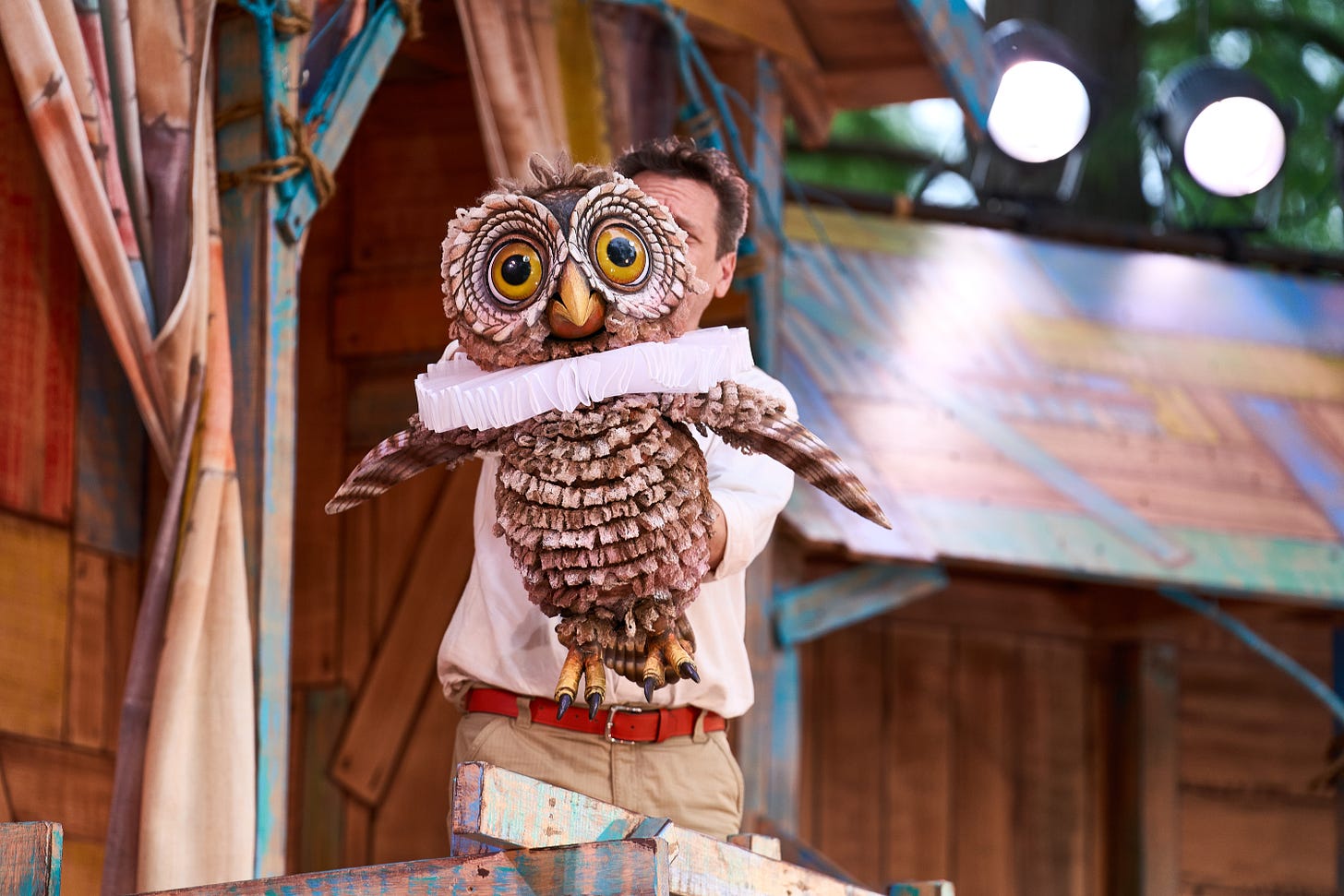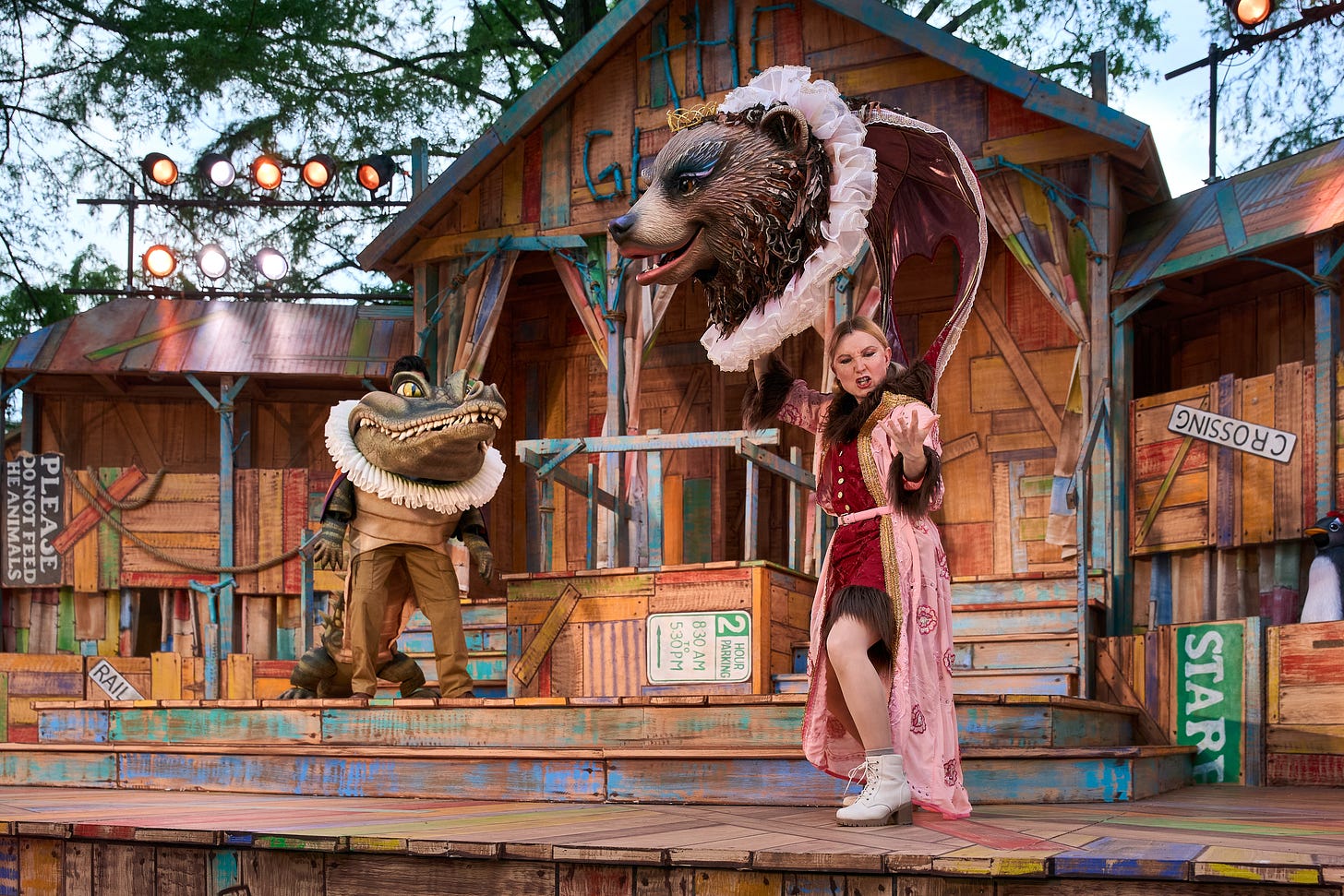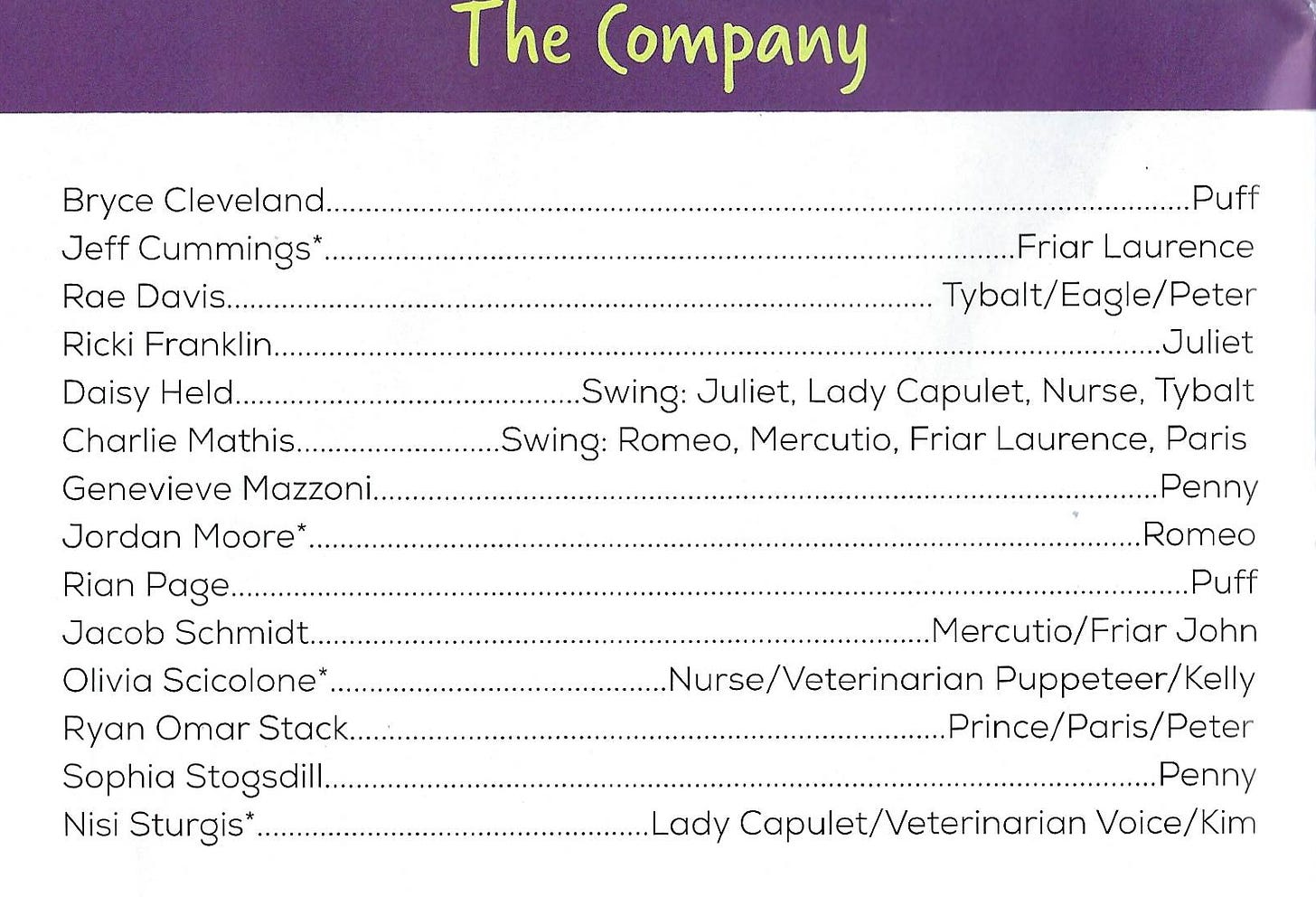Through August 17th: “Romeo and Zooliet” celebrates the zoo and Shakespeare, too
If we could talk to the animals, it would be in iambic pentameter
Someone told me
It's all happening at the zoo.
I do believe it.
I do believe it's true.
— Paul Simon, “At the Zoo” (1967)
[NOTE: Photos in this review are from the final dress rehearsal. I’ll replace them with production shots when available.]
What’s happening at the zoo through August 17th is Romeo and Zooliet, a charming, funny, and definitely family friendly adaptation/satire of Romeo and Juliet. It’s the first of what I hope will be a long and prosperous partnership between the St. Louis Zoo and St. Louis Shakespeare Festival.
A sort of mini-version of the regular festival, the production takes place on a free-standing stage (“The Glowb”) built on a hill—in this case, the Historic Hill at on the south side of the Zoo, just west of the Sea Lion house. The audience can bring their own chairs or blankets and sit on the grass or pay for an actual folding chair closer to the stage.
This being the zoo, all the characters are puppets modeled after zoo animals. Created by Michael Curry Design, they’re the bunraku-style puppets made famous by Disney’s The Lion King, which Curry designed in partnership with Julie Taymor. That means the actors are visible at all times, but they are so thoroughly invested in their characters that it quickly becomes hard to separate the two.
The puppets are irresistibly charming, especially grizzly cub Juliet (Ricki Franklin), prairie dog Romeo (Jordan Moore), and red panda Mercutio (Jacob Schmidt). Schmidt is also the bumbling tortoise Friar John, a puppet so lovably silly that he gets laughs just lumbering across the stage. Juliet’s verbose nurse is a life-sized hippo expertly piloted by Olivia Scicolone and the Prince is a sea lion (Ryan Omar Stack) meting out justice when he’s not being distracted by a beach ball. Heck, even the sinister alligator Paris (Stack), the bellicose tiger Tybalt (Rae Davis), and the domineering Lady Capulet (Nisi Sturgis, in truly intimidating headgear) are fun to watch.
There are times when “family-friendly” means “strictly for kids,” and Romeo and Zooliet certainly has enough slapstick humor to keep all but the smallest of small fry entertained. But it’s also stuffed full of more clever wordplay, local references, and Shakespeare in-jokes than you can shake a stick at if (to quote Groucho Marx) “that’s your idea of a good time.” My wife and I are old enough that our childhood a distant memory, and we found it thoroughly entertaining.
The script by Jennifer Joan Thompson is “set in fair Zoorona.” The plot is pretty much straight Shakespeare distilled down to 80 minutes and told in a mix of Elizabethan and modern English. In this version the feud is between the warring Montague (herbivore) and Capulet (carnivore) clans. Herbivores Romeo and Mercutio crash the carnivore ball hosted by grizzly Lady Capulet. Romeo and Juliet are captivated with each other and vow to be BFFs (best friends forever), even if it does mean sharing their toys. Nobody dies, although the star-crossed BFFs do end up hibernating together for “the next four to seven months.”
There are so many clever touches in this script that I can’t possibly mention more than a few of them. There is, for example, a hilarious gloss on the Abbot and Costello classic “Who’s on First” routine starring Friar Laurence (Jeff Cummings )who is, of course, a Barred Owl (just one of many silly puns). Then there’s the monolog by Romeo that’s a mash-up of at least a dozen Shakespeare soliloquies (a real tour de force by Moore).
And let’s not leave out the three animals in their box seat stage left. Peter the penguin (Stack, assisted by three other actors) and his daughter Penny (Genevieve Mazzoni, alternating with Sophia Stogsdill) are joined by cousin Puff the puffin (Rian Page, alternating with Bryce Cleveland) who files in (literally) at the last minute. Like Statler and Waldorf from The Muppet Show, they periodically jump in to comment on the action. Penny and Puff also tend to ask awkward questions about carnivore vs. herbivore lifestyles that Peter can’t always answer.
The unexpected entrance of Puff’s inanimate double via zipline is just one of many fanciful visual elements of the show. Scott C. Neale’s ramshackle Glowb Theatre is another one, along with imaginative costumes by Raquel Adorno and additional puppet fabrication by Caitlin McLeod. Jesse Klug has draped the flora in the audience area with a colorful mix of fairy lights, thereby enhancing the storybook ambience.
Choreographer Sam Gaitsch and Fight Choreographer Zev Steinrock keep the show in nearly constant motion, which gives the quieter scenes between Romeo and Juliet that much more impact. The moment when they share their toys is just too charming for words.
Direction by festival Producing Artistic Director Tom Ridgely makes clever use of the small stage and keeps the pacing brisk—essential when you have younger folks in the crowd.
Opening night was, I have to say, not without its issues. There was a 15 minute rain delay and as much snap, crackle, and pop in the wireless body mics as a bowl of Rice Krispies. When the entire audio system went out towards the end, Ridgely took to the stage and announced that, rather than delay the delay the show, the cast were going to go on “a cappella” because trained professionals can do that. He encouraged everyone to move closer to the action, which was probably a welcome offer for folks sitting on the lawn.
I mention all this not because I expect it to happen again (although with the rain, “one never knows, do one?”) but because it demonstrated unequivocally that this is a terrific cast of performers—some of them well short of voting age—who are undaunted by the unexpected. I have named a lot of names up to this point, but in case I missed anyone, here’s a complete list. They all acquitted themselves admirably. Every one of them is, to quote The Bard in Richard II, “a well-grac'd actor.”
In short, Romeo and Zooliet is great fun for all, no matter how much or how little you know about Shakespeare. It even manages to be educational because, after all, the Zoo is “animals always.” That makes it a fun family outing, and I highly recommend it.
That said, be advised that, unlike the main season production, there is no free seating. A spot on the ground can be had as little as $12 per person, but an actual chair will cost between $17 and $150. The latter include free parking and other perks. Performances begin at 7:30 pm; for ticket and date information, visit the St. Louis Zoo web site.











